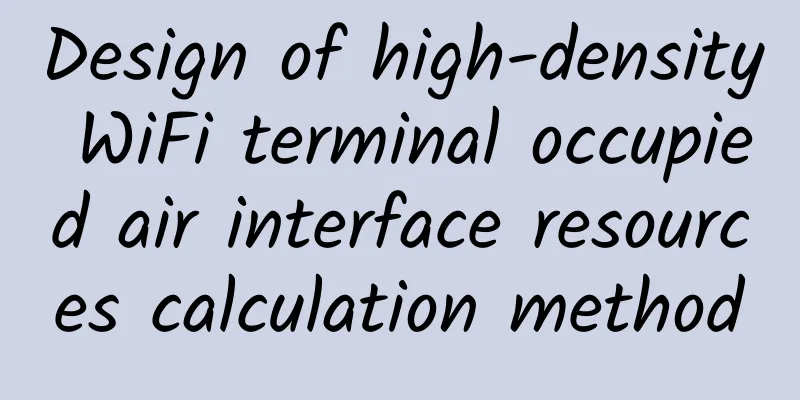Design of high-density WiFi terminal occupied air interface resources calculation method

|
In places where high-density WI-FI terminals are used, the more terminals that share air interface resources, the less air interface resources each terminal will occupy, thus affecting the overall throughput. So how do we calculate the air interface resources occupied by terminals in a Wi-Fi network environment? In this issue, we will discuss this issue.
First let's take a simple example: If there is only one AP in a room and only one laptop connected (see the figure below) The maximum TCP/IP transmission rate of the laptop is 220Mbps. Since there are no other devices connected to the AP, the laptop can monopolize 100% of the air interface resources. Therefore, it should be no problem to achieve a TCP/IP transmission rate of 220Mbps. Now we have another iPad connected to the AP The TCP/IP transmission rate of iPad is 70Mbps. Now that there are two terminal devices connected to the AP, each terminal device needs to share the air interface resources (50% each). As a result, the original TCP/IP transmission rate will be halved - the laptop's TCP/IP transmission rate will be reduced from 220Mbps to 110Mbps; the iPad's TCP/IP transmission rate will be reduced from the original 70Mbps to 35Mbps. The overall Wi-Fi network throughput will also be reduced from 220 Mbps when only the laptop is connected to 145Mbps. This shows the impact of the increase in the number of terminals on the Wi-Fi network throughput. In the above examples, we assume that the channel utilization rate can reach 100%, but in reality the channel utilization rate can generally only reach about 80%. So if we want to estimate how many APs are needed in a certain environment to ensure that users can obtain a transmission rate that meets their applications, what parameters do we need? 1. The TCP/IP bandwidth required by each terminal (Min. Bandwidth required by client) – This mainly depends on what application the terminal is running (web browsing, video streaming, voice...) 2. Maximum TCP/IP transmission rate of each terminal (Raw Bandwidth of client) 3. Number of clients Many people may be confused at this point. How to obtain these parameters? Don't worry, we will give the calculation formula below. 1. (Bandwidth required by the terminal / Maximum TCP/IP transmission rate of the terminal) x 100% = Air port percentage 2. (Air interface percentage x number of terminals) / 0.8 = Number of radios required The number of radios required is not equal to the number of APs required, because one AP can support multiple radios. |
<<: Reject poor digital experience! Riverbed creates agile and visual management solutions
>>: 7 ways artificial intelligence is impacting enterprise IT infrastructure
Recommend
What does a communications engineer do?
As a communications engineer, I have been asked t...
Comparing WiFi 6 and WiFi 5, there are three differences
[[430598]] The shopping festival is here. If you ...
A chart showing the first phase 5G deployment schedule of the four major US operators
5G is accelerating. 3GPP has completed the non-st...
Evoxt: $2.99/month-512MB/5GB/250GB/Hong Kong & Malaysia & Germany & UK & US data centers
This is the first time that Evoxt has been shared...
Ethernet welcomes new growth: Experts' view on automotive Ethernet and AVB technology
Before discussing automotive Ethernet, let’s take...
Dapr Practice in Alibaba Cloud Native
What is Service Mesh? Since 2010, SOA architectur...
Developing 5G communications requires testing first
"The 5G era is coming. China is seeking to &...
Foreign media said that the number of 5G base stations in Shenzhen has exceeded that of Germany by 50 times
According to foreign media, Germany's Handels...
The love-hate relationship between video surveillance networks and IPv6
Among the three major layers of the Internet of T...
How NFV and SDN will shape the future of telecommunications
The Internet has been developed for decades. Face...
8 networking options for 5G
Some people say that the path to 5G evolution is ...
How to deal with the new security challenges brought by 5G
Mobile network infrastructure has changed dramati...
In the cardless era, can eSIM gain a foothold in the IoT circle?
The basic functions of mobile phones remain uncha...
The launching ceremony of the 4th "Zhanhua Cup" 5G Application Collection Competition-Fujian Regional Competition and the Information and Communication Development Research Forum were successfully held in Xiamen
[[406599]] From left to right: Ye Kai, Song Zifu,...
HostKvm 20% off: Korea/Hong Kong CN2 data center VPS monthly payment starts from US$7.6
HostKvm was founded in 2013. It currently provide...









